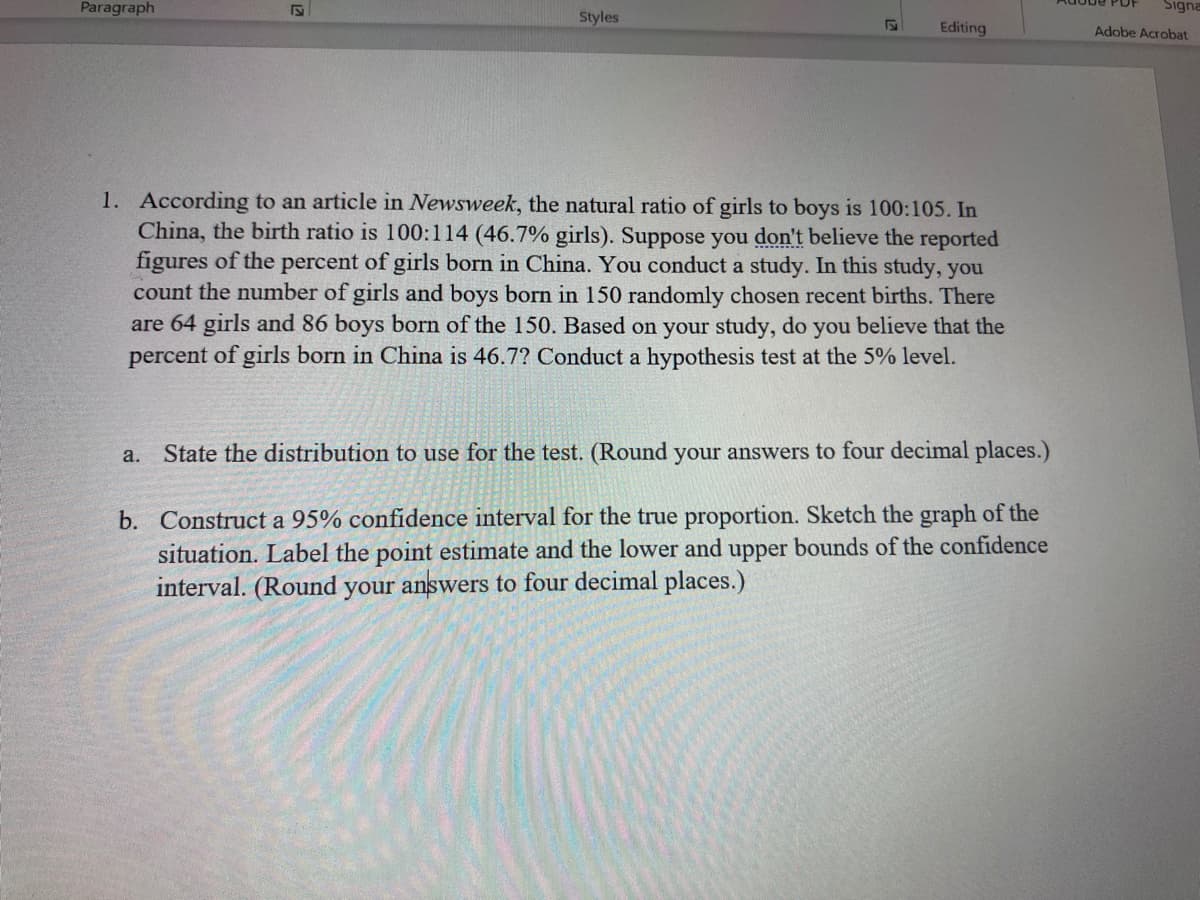1. According to an article in Newsweek, the natural ratio of girls to boys is 100:105. In China, the birth ratio is 100:114 (46.7% girls). Suppose you don't believe the reported figures of the percent of girls born in China. You conduct a study. In this study, you count the number of girls and boys born in 150 randomly chosen recent births. There are 64 girls and 86 boys born of the 150. Based on your study, do you believe that the percent of girls born in China is 46.7? Conduct a hypothesis test at the 5% level. a. State the distribution to use for the test. (Round your answers to four decimal places.) b. Construct a 95% confidence interval for the true proportion. Sketch the graph of the situation. Label the point estimate and the lower and upper bounds of the confidence interval. (Round your answers to four decimal places.)
1. According to an article in Newsweek, the natural ratio of girls to boys is 100:105. In China, the birth ratio is 100:114 (46.7% girls). Suppose you don't believe the reported figures of the percent of girls born in China. You conduct a study. In this study, you count the number of girls and boys born in 150 randomly chosen recent births. There are 64 girls and 86 boys born of the 150. Based on your study, do you believe that the percent of girls born in China is 46.7? Conduct a hypothesis test at the 5% level. a. State the distribution to use for the test. (Round your answers to four decimal places.) b. Construct a 95% confidence interval for the true proportion. Sketch the graph of the situation. Label the point estimate and the lower and upper bounds of the confidence interval. (Round your answers to four decimal places.)
Glencoe Algebra 1, Student Edition, 9780079039897, 0079039898, 2018
18th Edition
ISBN:9780079039897
Author:Carter
Publisher:Carter
Chapter10: Statistics
Section10.6: Summarizing Categorical Data
Problem 10CYU
Related questions
Topic Video
Question

Transcribed Image Text:Paragraph
Styles
Editing
Adobe Acrobat
1. According to an article in Newsweek, the natural ratio of girls to boys is 100:105. In
China, the birth ratio is 100:114 (46.7% girls). Suppose you don't believe the reported
figures of the percent of girls born in China. You conduct a study. In this study, you
count the number of girls and boys born in 150 randomly chosen recent births. There
are 64 girls and 86 boys born of the 150. Based on your study, do you believe that the
percent of girls born in China is 46.7? Conduct a hypothesis test at the 5% level.
a.
State the distribution to use for the test. (Round your answers to four decimal places.)
b. Construct a 95% confidence interval for the true proportion. Sketch the graph of the
situation. Label the point estimate and the lower and upper bounds of the confidence
interval. (Round your answers to four decimal places.)
Expert Solution
Step 1
The confidence interval for the population proportion,
Trending now
This is a popular solution!
Step by step
Solved in 3 steps with 1 images

Knowledge Booster
Learn more about
Need a deep-dive on the concept behind this application? Look no further. Learn more about this topic, statistics and related others by exploring similar questions and additional content below.Recommended textbooks for you

Glencoe Algebra 1, Student Edition, 9780079039897…
Algebra
ISBN:
9780079039897
Author:
Carter
Publisher:
McGraw Hill

Holt Mcdougal Larson Pre-algebra: Student Edition…
Algebra
ISBN:
9780547587776
Author:
HOLT MCDOUGAL
Publisher:
HOLT MCDOUGAL

College Algebra (MindTap Course List)
Algebra
ISBN:
9781305652231
Author:
R. David Gustafson, Jeff Hughes
Publisher:
Cengage Learning

Glencoe Algebra 1, Student Edition, 9780079039897…
Algebra
ISBN:
9780079039897
Author:
Carter
Publisher:
McGraw Hill

Holt Mcdougal Larson Pre-algebra: Student Edition…
Algebra
ISBN:
9780547587776
Author:
HOLT MCDOUGAL
Publisher:
HOLT MCDOUGAL

College Algebra (MindTap Course List)
Algebra
ISBN:
9781305652231
Author:
R. David Gustafson, Jeff Hughes
Publisher:
Cengage Learning